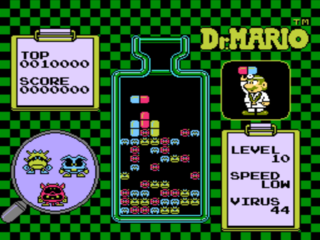Overview

Dr. Mario is a falling-block tile-matching puzzle game developed by Nintendo R&D1 and published by Nintendo for the Nintendo Entertainment System and Game Boy in Japan on July 27, 1990, with a North American release in late 1990 and a European release in 1991.
A puzzle game spin-off of the Mario series and similar in playstyle to Sega's 1989 game Columns, Dr. Mario tasks players with clearing the 8×16 playfield of "virus" blocks by using them to form a four-or-more match of the same color (horizontally or vertically) by moving and rotating two-block "capsule" pieces. The game includes three colors of blocks, with the NES version including blue, red, and yellow and the Game Boy version including black, white, and gray.
One of the more well-known of Nintendo's puzzle game offerings, Dr. Mario received multiple sequels, remakes, and spin-offs, with the titular character "Dr. Mario" later being known for his inclusion in the Super Smash Bros. series of fighting games. It also inspired a mini-game in the Brain Age series, known as "Virus Buster". Both versions of the game received multiple ports and re-releases to other consoles over the years:
Gameplay

Dr. Mario is a puzzle game in which players utilize two-block capsules (with each block having one of three colors) to form a line of four-or-more blocks of the same color (horizontally or vertically), clearing them and possibly granting score. When matches are made, all connected blocks fall down from gravity, potentially causing a chain reaction.
Similar to the Sega game Flash Point, the game includes a stage-based objective where players have to clear designated blocks (known as "virus" blocks) from the pre-populated 8×16 playfield to complete the Level. Players earn score by clearing virus blocks from the board, with bonus points for clearing multiple virus blocks at once (at an exponential pace, from 100, to 200, 400, 800, etc.) and for playing the game with a faster play speed (×1 for Low, ×2 for Med, and ×3 for Hi).
As players progress through each level, more virus blocks are added at the start (with the highest, at Level 20, starting with 84 total virus blocks). Players can choose their starting Level, as well as their play speed (with faster speeds granting a bonus score multiplier and opportunities for bonus cutscenes). The more time players spend on a particular Level, the faster the game speed becomes, regardless of their chosen play speed (although this does not affect score).
Along with the standard single-player game, Dr. Mario includes a two-player versus multiplayer mode where both players race to clear their designated playfield of all virus blocks (in a best-of-five scenario). Each player can choose how many virus blocks to start with and their play speed (for player handicaps), and players can "attack" each other with dropped garbage blocks on larger clears and chain clears. The Game Boy version makes use of the system's link cable.
Log in to comment